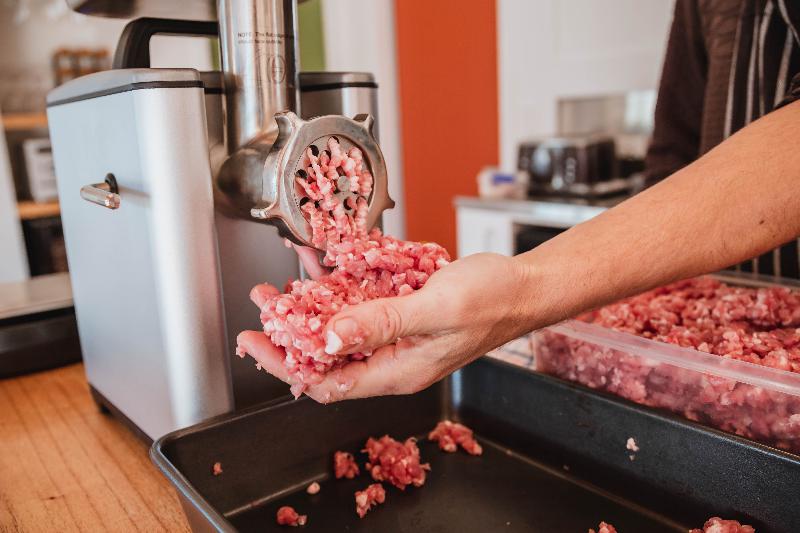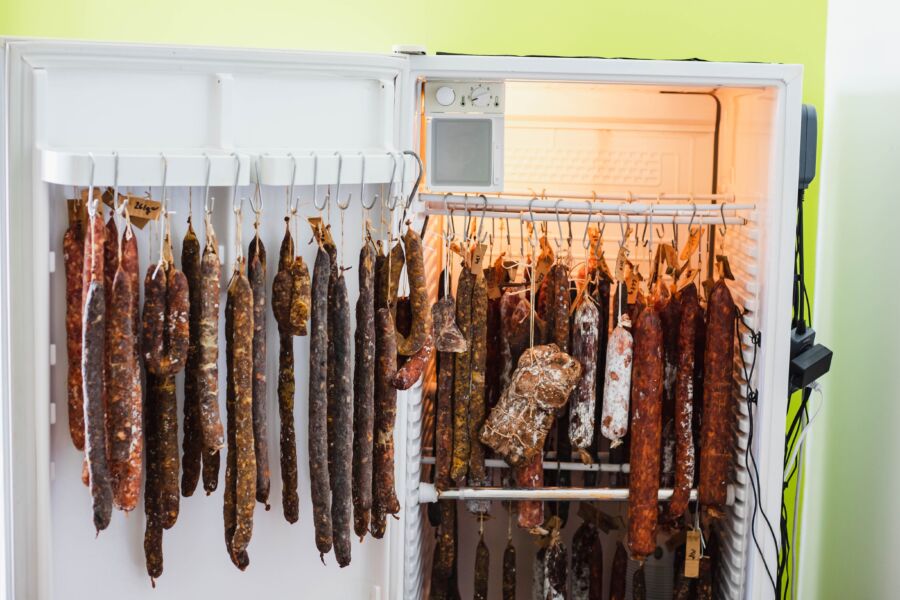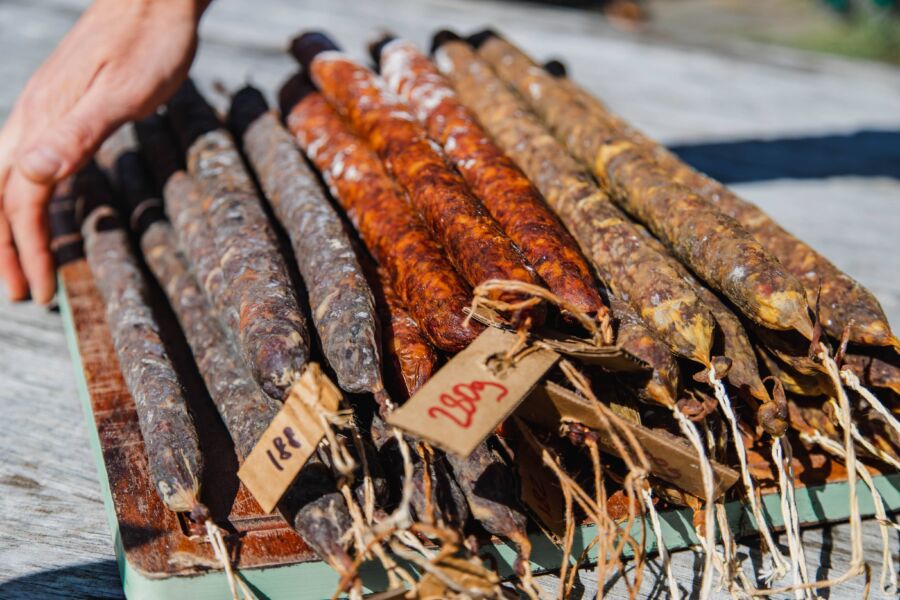When it comes to mincing meat for salami and sausages, I think you want some subtleties and mincer/grinder designs in your equipment.
Over the years, I have used many different types of meat mincers, from cheap to more expensive to commercial equipment.
Through my experiences and product testing, I’ll highlight the product designs that will not be effective in sausage or salami making in my experiences over 20 years.
Since you are looking for a mincer, I’ll cover aspects of grinding and mincing related to sausages, patties, or salami making (here are some simple salami kitsI), which is highly relevant.

What Features Makes a Decent Meat Mincer or Grinder
- Heavy Design
- Stable Base
- Robustly Made Materials
- Good Powerful Motor or Decent Crank Handle
- Freezable Parts
- Attachments

Heavy Design
When processing meat, you don’t want a light mincer—it has to stand firmly on your benchtop, or it may slip around while mincing, in my experience.
A heavy mincer doesn’t slip around; you can get on with cleanly cutting.
Stable Base
I prefer to have feet on the bottom rather than mincers in the form of suction caps; these tend to fail with the amount of moisture or chunks of meat on your benchtop when you’re processing.
This is also where weight can come into play.
Robustly Made Materials
Generally, stainless steel is a type of metal that will last longer than carbon steel in the blades.
Speeds – having a slow/fast option helps a lot. You won’t get the smearing at a lower speed. Also, many cheap ones don’t have a reverse speed for unclogging, cleaning, or slow speed.
Robust Motor / Decent Crank Handle
Most meat miners on the market for residential or for-home use will have barely a 1/4 horsepower and not enough accurate output; this means the engine or motor has to work very hard against all the resistance of the thick chunks of meat proteins.
Many online models focus on the ‘wattage’ – so it’s like 2,000W output. It’s often just a marketing number not relevant to performance.
If you want effective cutting or chopping from a mincer, I suggest looking at a minimum of 1/2 HP for decent mincing workloads.
Metal Gearing inside the motor is far better than some cheap plastic cogs on the market and, of course, a copper motor. If you pay under $100 for a mincer; you tend not to have these design aspects.
If you only use your mincer occasionally to make patties, for example, you could get away with something basic, manual, or non-electric.
You don’t want meat mushed together when making your salami or fresh sausages, We call that ‘mystery meat’ as you never know what’s inside, such as in a saveloy or hot dog. Read the ingredients in a commercial hot dog, often 50-60% meat.
I understand if you want to make an ’emulsion-style sausage. But I am generally talking about having a clean separation between the meat and fat, whether it’s a fresh sausage or salami.
Manual Meat Grinder
For one-off grinding, stable-built manual meat grinders are also a good option. Most will have a foot clamp system to secure it to a bench.
Sharp Blades
If you get a good meat mincer – as I have suggested on this page and talked about across this blog – you invest in a mincer with decent sharp blades and make hundreds of kilos of meat go through these machines without needing to sharpen.

When you notice the blades dull, it is best to buy replacement blades.
If you buy a mincer from a reputable brand, you’ll have no problems sourcing these blades.
The number of blades can also vary; 2,3 or 4 are available. 3 or 4 are most common; 2 are not so much for grinding, more for mixing, with a bit of cutting involved.
Freezable Parts
There is a big difference between a meat miner and a grinder with plastic rather than solid metal parts.
In the warmer months, when making sausages, I like to put that drill (like a corkscrew inside the mincer) in the freezer for half an hour before any mincing commences.
Much of the heat produced from the motor and the moving parts means drills are the first components that heat up.
The auger and the blades are other things that you can freeze for a bit before your mince-making. Suppose it is made out of solid steel metal parts.
However, you need sturdy metal components; plastic parts will shatter. Some miners have caps over the blades and plastic plates, which will not be suitable for freezing before grinding.
Appropriate Attachments
I use a 6 mm blade for many variations to make sausage mince. For mincing chicken, fish, or pigeon (pigeon breast makes a good South East Asian Larb) – you may want to have different-sized blades (maybe finer 3-4 mm).
Having at least a few options is critical; 8 mm is pretty chunky, and 3mm is pretty okay.
5-6mm works for most meats for me.
I don’t think a sausage-stuffing device is useful on electric machines. It would be best always to have the right tool for the job. It can work, but I haven’t had much success; I prefer using a manual stuffer with a crank.
Although electric stuffers are used in commercial production, the design of domestic stuffers/grinders I have found often creates heat.
Flawed Meat Grinder Designs Aspects
I would preferably chop meat into mince with a knife rather than smearing my meat.
I want to highlight elements for meat miners and grinders that you do not wish to.
Plastic Design
Grinders and minces dominate the market, and they come at a cheap and cheerful price.
I do not recommend purchasing anything like this for decent batches of any sausage. Expect broken bits of metal and plastics in your sausages.
Look at many plastic mincer reviews often 30% are 3-star or below.
Multi-Tool Equipment
Certain brands, like KitchenAid, have attachments for mincing; again, they fall into this category, and I would avoid them.
What is the difference between a meat grinder and a meat mincer?
There is no difference, in my opinion; they are both using blades to grind or chop the meat.
Use a Manual, Not Electric, for Stuffing
Heat can cause an issue when using an electric stuffer or miner. You might end up with emulsion and binding.
Ideally, a manual sausage-stuffer, vertical or horizontal, is, in my opinion this is the way to go.
It’s a lot of fun with the crank handle when one person on one end and another on the other end communicate and apply the casing for a horizontal stuffer.
Both ends of the stuffer are managed and controlled based on the feeling and resistance.
I wrote some more about sausage stuffers here.
Ways You Grind Meat for Salami or Fresh Sausages
- Emulsion
- Binding
- Clean Cutting
- Cold Cutting
Emulsion
Emulsion happens when you can’t determine the meat, like baloney. An incredibly cheap form of Italian mortadella, an emulsified sausage containing pistachios.
Classic Commercial Baloney Ingredients:
Mechanically separated meats – google this it’s scrappings (chicken and turkey and/or pork), pork and beef and/or bacon; water, modified corn starch, salt, soy protein isolate, potassium lactate, sugar, spices (contains mustard), sodium phosphate, sodium erythorbate, monosodium glutamate (MSG), sodium diacetate, sodium nitrite, smoke flavor, wheat flour, milk ingredients. It contains soy, mustard, wheat, and milk.
Homemade Baloney
Beef, Pork, fat trimmings, Potato flour, Salt, Sodium Nitrite (maybe), white pepper, paprika, nutmeg, garlic, water
Homemade Mortadella
Pork, Salt, Red Wine, Pistachios, Water, Nitrites (Maybe), seven spices, (Mainly Pepper)
For most sausage- or salami-making, the mincing should not become emulsified meatballs. It is pretty apparent when the mince shows a pinkish color as it blends.
You grind the meat several times to get the emulsified effect for certain types of specialty German sausages such as ‘Weiss Wurst’ (a pale sausage which is cooked in water and eaten at 4 am in the ‘German Beer Hall’ for sustenance after partying (it’s a tradition in Munich – that’s what my mum told me). This was way before Octoberfest got popular…
The goal of mincing for salami is to get coarsely chopped meat.
Another example of an emulsified sausage is a Frankfurter. Most Frankfurter recipes involve putting the meat through a grinder three times and using a 5 mm plate and then a 3 mm plate.
Binding
For decent sausages or salamis, you have to get the binding right. This is called forcemeat or farce once it’s been all mixed and mushed up properly.

For this, you want to release certain types of myosin in the proteins of the meat so that the meat gets a little bit tacky and sticky. Working the meat with sticky hands is a lot of fun for me and many guys until you get this binding effect.
Emulsion and binding are similar but still different.
A true emulsion is a colloidal suspension of two immiscible liquids (i.e. two liquids which are not soluble in each other, as in the case of oil and water). Typically, a non-polar liquid is dispersed within a polar liquid. A third component, an emulsifying agent is required for the development of a stable emulsion. The emulsifying agent acts at the interface between the fat and water to prevent coalescence of the fat (i.e. to prevent fat pockets or caps). Good examples of oil-in-water emulsion are mayonnaise and milk.
Meat Emulsion – Science
The old classic way of knowing when that bind has reached the right level for dry-cured salami is to make a little pattie with your hand.
Turn your hand upside down.
If it sticks, it’s ready!
Clean Cutting
Clean meat cutting is a lot about the blades’ sharpness and the motor’s power.
So, do not get lazy when trimming the sinew of the meat.
I’ve noticed the horsepower of the motor can make it easier. But it works best with most or all of the sinew of the meat that is carefully cut off (it takes time for wild meat but is worth the effort).
Cold Cutting
I mentioned this before: having the blades and drill in the freezer for half an hour helps.
If you’re making sausages or salami, you should note that working at a temperature just above freezing point is ideal and also a health and safety aspect.
This is one reason I am careful about teaching people the aspects of chopping and mincing meat: You are exposed to the environment,, which may lead to undesirable outcomes.
I urge you to follow hygienic and food safety principles.
The Single-Use / Throw-away Equipment Culture
“Good Things Aren’t Cheap, And Cheap Things Aren’t Good”
A friend likes to say the above, and I think it applies also to meat mincing and grinding – like many other things in life.
Investing more will mean it lasts years, decades, and not months.
For instance, you will find maybe $100 cheap meat mincers at’ Amazon’.
If you’re only going to use this a few times a year and doing small batches then this type of meat mincer will be fine, get the one below.
I suppose you’re reading this because you want to make decent amounts of salamis and sausages and want your machine to run longer.
Then you will need a mincer to do the job properly.
Here are some suggested mincers that fulfill the above criteria:
Meat Mincer/Grinder for Salami and sausages
- Kitchener Electric Meat Grinder Sausage Stuffer #8 1/2 HP (Semi-Commerical model)
- Kitchener Meat Grinder Sausage Stuffer Elite 1/2 HP (Residential model)
- LEM Mighty Bite – 1158 (Low Volume)
- Man 304 Stainless Manual Meat Grinder
| Kitchener #8 Commercial | Kitchener Elite Residential | LEM Mighty Bite – 1158 | 304 Stainless Meat Grinder – No. 10 Size | |
| Weight | 38lb | 18lb | 17lb | 5.7lb |
| Size (inches) | 18.5 x 15 x 15″ | 15 x 13 x 9″ | 24 x 24 x 17″ | 12.9″ x 12.4″ x 6.5″ |
| Speed Control | Fast, Slow & Reverse | Fast, Slow & Reverse | Fast, Slow & Reverse | Manual |
“A lot of mincers and grinders talk about capacity per hour – it’s never going to apply. Since, when it gets warm/hot you stop and have a break and cool the meat in you’re fridge/freezer”
If you ran any mincers for an hour it will burn out the motor”
Quote – Tom Mueller, Eat Cured Meat

Tom Mueller
For decades, immersed in studying, working, learning, and teaching the craft of meat curing, sharing the passion and showcasing the world of charcuterie and smoked meat. Read More
